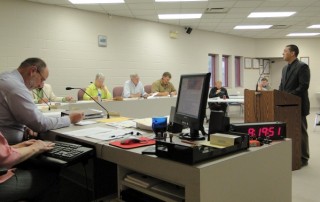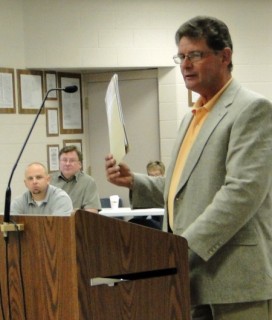by PCJ Editor Wayne Senville, reporting from Elkhart County, Indiana
Elkhart County, Indiana. Some quick facts. Population: 198,000. Location: northern Indiana, just south of the Michigan line. “Capital” of America’s RV industry. Unemployment rate: 18%. Close to South Bend (20 miles) and Chicago (110 miles).

I spoke with members of the Elkhart County Plan Commission about the impact of the economy on planning and development — and I’ll touch on this later in this post.
But I just happened to be in Elkhart County on the day the Plan Commission’s meeting was focusing on a proposed zoning amendment to regulate digital electronic signs, LED’s. In fact, it’s one of a series of meetings the Commission has had on this.
It’s a fascinating, and challenging issue — one facing communities across the country.
There’s been a surge in digital signs in Elkhart County. This, in turn, has led to a growing number of complaints, especially from residents. As staff planner Robert Nemeth (at podium in above photo) told me, the main concern he’s heard is about their brightness and intensity, and the way “they can light up the whole neighborhood.” Moreover, as Nemeth pointed out to the Commissioners, “we’re looking to the future … as digital signs are becoming cheaper, more and more businesses will be using them.”
Video above of Horizon Bank sign in Elkhart County, just up the road from where we were meeting. Below: also nearby, this gas pricing sign is the kind of digital display of information that seldom raises any concerns.
 Right now, all such signs are permitted in Elkhart County. Planning staff drafted a zoning amendment, drawing on regulations used in other communities. Staff also got input from Lyle Ryman, who runs Sign Image, a local business that has installed some 50 LED signs. Ryman told the Commissioners that billboard size electronic signs “will be the wave of the future in a big way,” and he has a client currently planning to install five of them in Elkhart County.
Right now, all such signs are permitted in Elkhart County. Planning staff drafted a zoning amendment, drawing on regulations used in other communities. Staff also got input from Lyle Ryman, who runs Sign Image, a local business that has installed some 50 LED signs. Ryman told the Commissioners that billboard size electronic signs “will be the wave of the future in a big way,” and he has a client currently planning to install five of them in Elkhart County.
Nemeth outlined some of the objectives of the proposed zoning amendment:
- prohibiting flashing, swirling, and animations, but allowing the sign display to change enough “so that it can convey information, but not distract drivers.”
- limiting the intensity of the light, to reduce glare at night and on overcast days.
- controlling signs in residential and agricultural areas, “where they’re just incompatible.”

One concern Ryman noted about the proposal was its restrictions on animations. For businesses, Ryman said, “animations are really important.” In fact, he added, “every one of our full color signs has animation.” He also pointed out that the City of Elkhart just purchased a large digital sign for their downtown plaza that will have animated displays.
The presentations triggered a series of questions from the commissioners. They ranged from technical (i.e., how do you define “night”; how do you measure and enforce light intensity standards) to philosophical (i.e., the degree to which government should regulate private businesses, though everyone on the Commission seemed at least sensitive to the business impacts of regulation).

There was also disagreement on basic issues such as how distracting digital signs, especially those with animation, are for motorists. Chairman Mike Yoder had few concerns, and noted that, “there’s a huge market telling us we have to have motion in these signs.” But Commissioner Steve Warner was concerned about having their impact at high traffic intersections where they might especially distract drivers. For Commissioner Meg Wolgamood, “it’s so complicated, because we’re not looking at just one sign, but at possible strips of signs in motion that could be distracting and confusing.”
See video below prepared by the South Carolina Chapter of Scenic America on potential impact of strip digital billboards.
As I noted, Lyle Ryman, the sign industry’s “representative,” has been working with Planning Department staff, and offered several constructive suggestions. He also mentioned the next generation of digital electronic signs that will convey holographic images.
See example below of a holographic billboard installed in Peru, visible from about 1,000 feet.
Large billboard size digital sizes are increasing across the country. Here’s one example along the Bay Bridge in California.
But there was no one at the table representing “the other side.” Indeed, how would the Elkhart County Plan Commission even find someone to represent a different point-of-view on signs? Organizations such as Scenic America which have campaigned against digital signs are small and far removed from places like Elkhart County.
note from Wayne Senville: for two very different viewpoints on digital signs, including information on their traffic safety impacts, see Scenic America’s web resources on digital electronic signs and then the web page of the Outdoor Advertising Association of America.

The Commissioners also discussed what to do about grandfathering existing signs. One intriguing difference that comes into play with digital signs, as Ryman pointed out, is that almost all are computer programmed. That means things like the speed of display and whether or not animations are displayed, can be turned on or off by the program. In other words, setting new zoning standards would not require the business to replace its existing sign.
While this should ease concerns about the financial impact of new criteria on existing signs, Commissioner Blake Doriot was still troubled by restricting a businesses’ right to use an existing digital sign in whatever ways allowed when they purchased it.
After over an hour’s discussion, the zoning amendment was tabled, so staff could address the concerns raised during the meeting. I’ll try to update this posting once Elkhart County takes action. I’d also welcome feedback on whether the topic of digital electronic signs is something we should address in a future issue of the Planning Commissioners Journal.
For a report on the same meeting that ran in the Elkhart Truth, see “Flashy signage may get dimmed by county rules.“
——————————-
Let me take a minute to touch on some other issues several planning commissioners told me about in an informal post-meeting discussion.
One big concern is how to diversify Elkhart County’s economy, and how planning and zoning relates to this. Plan Director Bob Watkins said that planners need to do a better job selling the public and elected officials on the importance of good zoning to economic development. As Watkins put it, “why would a big company want to come to Elkhart County if they didn’t know who might be setting up next to them?”
Mike Yoder (who is also a county commissioner) seconded this. “Too many developers,” he observed, “believe all you need to do is put up something cheap.” Meg Wolgamood (who used to be a planner for Elkhart County) added, “we’ve all talked about raising the bar, and we’ve improved our standards, but with the economy the way it is here, there’s a temptation to backslide.” Yoder nodded, saying “we’re trying to move from basic manufacturing to advanced manufacturing … raising the bar is actually pro-business.”
The future of manufacturing is a major concern here in a county that for long has thrived from the RV industry, which has been especially hard hit by the recession (one reason why President Obama paid a return visit to Elkhart this February to speak about his economic stimulus plan). Watkins pointed out that there’s some 94 million square feet of manufacturing space in Elkhart County, noting that it will be a challenge to find new uses for this space.
But Elkhart County has some competitive advantages: very good road and rail infrastructure, low housing and business costs, proximity to Chicago, and the fact that the County sits on a huge aquifer.
For an interesting article on some of the challenges facing Elkhart County, see “Can Elkhart County Save Itself?” (published in the Elkhart Truth, March 29, 2009).
Editor’s Note: We covered billboards extensively in 2011, including an article by contributing writer Ed McMahon; a follow-up conversation with McMahon; a response from the Outdoor Advertising Association of America; a further reply from Scenic America; and finally my own thoughts on billboard regulation in Vermont (where our business is located).
